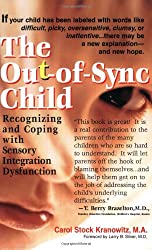This is a challenging topic.
*This post contains affiliate links and I may receive commission when you click on links and make purchases. However, this does not impact the price you pay!

You’ve likely heard of it before, which is probably why you’re here. I want to start by saying that processing sensory information is something we all do every day, at nearly every moment. This is going to be a general explanation of processing sensory input because it could get quite lengthy. If you want more information that is more dense and science-based, be sure to check out my reference section on this one! I particularly love these two books; the first for parents and older children (on the right), the second for parents (below).

Our sensory system takes in information from both our environment and internal cues and tells us how to respond. It impacts our motor skills, our emotional regulation, our perception of an environment, how we learn, and how we react to certain situations. We all process this information differently. For most, it is subconscious and does not impact their every day activities. For others, there are certain things that they notice or struggle with, possibly due to a difference in processing. And for some, it makes daily tasks like brushing hair, putting on clothing, riding a bike, and falling asleep a daily challenge.
I have a disclaimer on all of my posts, but this one needs a reminder: I do not diagnose. Occupational therapists do not diagnose. I rarely use the term “Sensory Processing Disorder” and prefer “Sensory Processing Difference”. There are many OTs in this world that specialize in and are trained in sensory integration. I am not one of those OTs. My philosophy and training has not led me on that path in my practice. However, many children have sensory processing differences, and I feel I am very experienced in it. So lets get on with it.
Studies estimate between 5-13% of children meet criteria for Sensory Processing Disorder. And this rate is higher among children with developmental delays or disabilities. This includes children with alternate diagnoses such as Autism, ADHD, anxiety, learning difficulties, Down syndrome, cerebral palsy, seizure disorders, among others. Please, please reach out to your primary care physician if you think your child would benefit from this approach.
5-13% of children meet criteria for Sensory Processing Disorder.
–Ahn, R, et al.
What I want to discuss in this post is the basics. Sensory processing is based on taking in information with all of our senses… and guess what. There are more than 5 (*insert gaping mouth emoji here*).
- Auditory (hearing)
- Olfactory (smell)
- Tactile (touch)
- Visual (sight)
- Oral (taste)
- Vestibular (movement and balance)
- Proprioception (body awareness and input to our muscles and joints)
- Interoception (internal cues such as temperature, fatigue, hunger, pain)
Sometimes, an individual processes information from these senses more differently than the norm. They may be more or less sensitive to the information than others are. There is certainly a normal range of sensitivities. Some people don’t love loud noises and get distracted easily while others require background noise to work (your auditory sense); some people love going on roller coasters and others get carsick going around the block (your vestibular sense); some people detest spicy/pickled/tart foods and cannot tolerate them while others love them (your oral sense); some people dislike hooded sweatshirts or scarves, while others don’t notice them (your tactile sense)… you get the point. If you, as an adult, have found that you have preferences like these, you have likely figured out what you need and want to do to feel better about these preferences. You likely have adjusted by buying the clothes you like, eating the foods you prefer, and avoiding situations that are challenging for you. For children, however, there are many barriers to their ability to do this:
- They lack the cognition and meta-analysis to understand their needs and reason through situations.
- They have little control over their schedule, the clothes they wear, the food they eat (check out my post on picky eating), environment, what they do during the day.
- They have a decreased ability to say (calmly or not), “Mom, I’m feeling nervous to go get my haircut because the hairs on my neck, the sound of the buzzer, and the smell of the products make me want to crawl out of my skin.”
As a result, we can oftentimes see meltdowns or negative behaviors. You could consider this as the “fight or flight” phase coming into play. A child’s system is so heightened or overloaded that they shut down, run away, or can become aggressive. This doesn’t mean that a child is “behavioral”. They are simply exhibiting a behavior as a result of an antecedent and in this case, it may be sensory related. Typically, this is where OT steps in. We provide strategies and ways to better tolerate or appropriately obtain input when children fall on the outsides of the ranges mentioned in the above paragraphs. When our sensitivities or desires for input become so strong that it impacts our daily activity participation, you might need some OT.
How to help a child who processes sensory information differently
If you are feeling stuck, would like to learn more, or would like to assist your child in his/her ability to get through the day, check out these posts (some of them may be coming soon!). If I attempted to address all of these things in one post, it would get novel-ly and overwhelming. So check out the ones that apply to your situation! Remember to just keep loving that little child with all your might. Some day, they just might thank you for it.
Strategies for regulation
Strategies for seeking out input
Strategies for avoiding input
Community participation
Chewing, biting, mouthing
Anxiety
Challenging Behaviors
So tell me. What do you know about sensory processing differences? What questions do you have! Let’s discuss.
-Ahn, R. R., Miller, L. J., Milberger, S., & Mcintosh, D. N. (2004). Prevalence of Parents Perceptions of Sensory Processing Disorders Among Kindergarten Children. American Journal of Occupational Therapy, 58(3), 287–293. doi: 10.5014/ajot.58.3.287
-Emmons, P. G., & Anderson, L. M. K. (2006). Understanding sensory dysfunction: learning, development and sensory dysfunction in autism spectrum disorders, Adhd, learning disabilities and bipolar disorder. Philadelphia: Jessica Kingsley Publishers.
-Kranowitz, C. S. (2011). The out-of-sync child: recognizing and coping with sensory processing disorder. Place of publication not identified: Paw Prints.
-Mucklow, N., & Hartwig, T. (2009). The sensory team handbook. Kingston, Ont.: Michael Grass House.
–https://www.spdstar.org/basic/subtypes-of-spd




Just encouragement – first, congratulation on starting your blog. Visually is it very inviting and calming. I chose to read the details on sensory processing because professionally I’ve always had an interest in this area. Your information was well written; clear, organized, and easy to follow and understand. Just enough information for definition and strategies and not too much to overwhelm or worry. Providing further information for those that need these resources gives ones a place to go next – when ready. I wish I had this blog available to me when I was a practicing nurse/nurse practitioner. I will happily and confidently share your blog. Very well done!
Jill, thank you for your support! I plan to write much, much more on this topic. It is challenging and can get confusing and misunderstood for many involved. I’m still trying to figure it out! I love this field because I’m constantly learning. I’d love your opinion as I value interdisciplinary practice so much! Thank you thank you for visiting and I look forward to having you 🙂
Like!! I blog quite often and I genuinely thank you for your information. The article has truly peaked my interest.
Glad to hear!